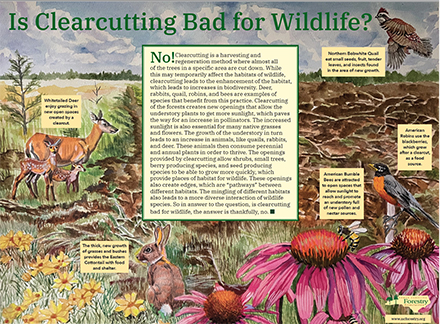Abigail Ridge, an intern at the North Carolina Forestry Association (NCFA) recently developed a creative way to answer the question about whether clearcutting is bad for wildlife. Source: Timberbiz
Ms Ridge did this through a piece of engaging and informative artwork. Working with artist Jan Pulley, Ms Ridge managed the process of bringing her original educational wildlife poster concept to life, which displays the benefits of clearcutting to various wildlife.
As Abigail’s poster illustrates clearcutting is a harvesting and regeneration method where almost all of the trees in a specific area are cut down. While this may temporarily affect the habitats for wildlife, clearcutting leads to the enhancement of the habitat, which leads to increases in biodiversity.
Deer, rabbits, quail, robins, and bees are examples of species that benefit from this practice. Clearcutting of the forests creates new openings that allow the understory plants to get more sunlight, which paves the way for an increase in pollinators.
The increased sunlight is also essential for many native grasses and flowers. The growth of the understory in turn leads to an increase in animals, like quail, rabbits, and deer. These animals then consume perennial and annual plants in order to thrive.
The openings provided by clearcutting allow shrubs, small trees, berry producing species, and seed producing species to be able to grow more quickly, which provide places of habitat for wildlife. These openings also create edges, which are “pathways” between different habitats. The mingling of different habitats also leads to a more diverse interaction of wildlife species.
So, in answer to the question “is clearcutting bad for wildlife,” the answer is no. You can download the poster here: Clear Cut poster 24 x 18 YELLOW box (004)-final






